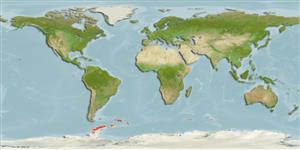>
Perciformes/Notothenioidei (Icefishes) >
Nototheniidae (Cod icefishes) > Nototheniinae
Etymology: Gobionotothen: Latin, gobius = gudgeon + see under Notothenia; gibberifrons: gibberifrons from Latin giber a hump, frons forehead, humped forehead (Ref. 11892).
More on author: Lönnberg.
Environment: milieu / climate zone / depth range / distribution range
Écologie
marin démersal; profondeur 6 - 429 m (Ref. 11892). Polar; 53°S - 67°S, 75°W - 75°E
Southern Ocean: Scotia Arc and Heard Island. Also distributed in the South Atlantic, near the southern Shetland, southern Sandwich, southern Orkney Islands, and near South Georgia Island (Ref. 4883).
Length at first maturity / Taille / Poids / Âge
Maturity: Lm 37.7 range ? - ? cm
Max length : 55.0 cm TL mâle / non sexé; (Ref. 5179); common length : 40.0 cm TL mâle / non sexé; (Ref. 2121)
Épines dorsales (Total): 6 - 8; Rayons mous dorsaux (Total): 31-34; Rayons mous anaux: 31 - 34. Upper part of head and body irregularly spotted and blotched. Rarely with traces of darker cross-bars, young with irregular cross-bars, broken up into three or four series of alternating spots (Ref. 11892).
Mature females may spawn for the first time from around 6-8 years of age (Ref. 71843).
Dewitt, H.H., P.C. Heemstra and O. Gon, 1990. Nototheniidae. p. 279-331. In O. Gon and P.C. Heemstra (eds.) Fishes of the Southern Ocean. J.L.B. Smith Institute of Ichthyology, Grahamstown, South Africa. (Ref. 5179)
Statut dans la liste rouge de l'IUCN (Ref. 130435)
Menace pour l'homme
Harmless
Utilisations par l'homme
Pêcheries: intérêt commercial mineur
Plus d'informations
CollaborateursImagesStamps, Coins Misc.SonsCiguateraVitesseType de nageSurface branchialeOtolithesCerveauxVision
Outils
Articles particuliers
Télécharger en XML
Sources Internet
Estimates based on models
Preferred temperature (Ref.
123201): -1.3 - 0.7, mean -0.6 °C (based on 36 cells).
Phylogenetic diversity index (Ref.
82804): PD
50 = 0.5312 [Uniqueness, from 0.5 = low to 2.0 = high].
Bayesian length-weight: a=0.00407 (0.00344 - 0.00483), b=3.24 (3.19 - 3.29), in cm total length, based on LWR estimates for this species (Ref.
93245).
Niveau trophique (Ref.
69278): 3.3 ±0.2 se; based on diet studies.
Résilience (Ref.
120179): Faible, temps minimum de doublement de population : 4,5 à 14 années (Fec=21,699; tm=10).
Fishing Vulnerability (Ref.
59153): Moderate vulnerability (42 of 100).
Climate Vulnerability (Ref.
125649): Moderate to high vulnerability (46 of 100).
Nutrients (Ref.
124155): Calcium = 19.7 [11.5, 46.6] mg/100g; Iron = 0.384 [0.181, 0.754] mg/100g; Protein = 17.7 [15.5, 19.6] %; Omega3 = 0.329 [0.180, 0.572] g/100g; Selenium = 16.6 [7.0, 41.1] μg/100g; VitaminA = 12.4 [2.7, 59.6] μg/100g; Zinc = 0.497 [0.332, 0.747] mg/100g (wet weight); based on
nutrient studies.
